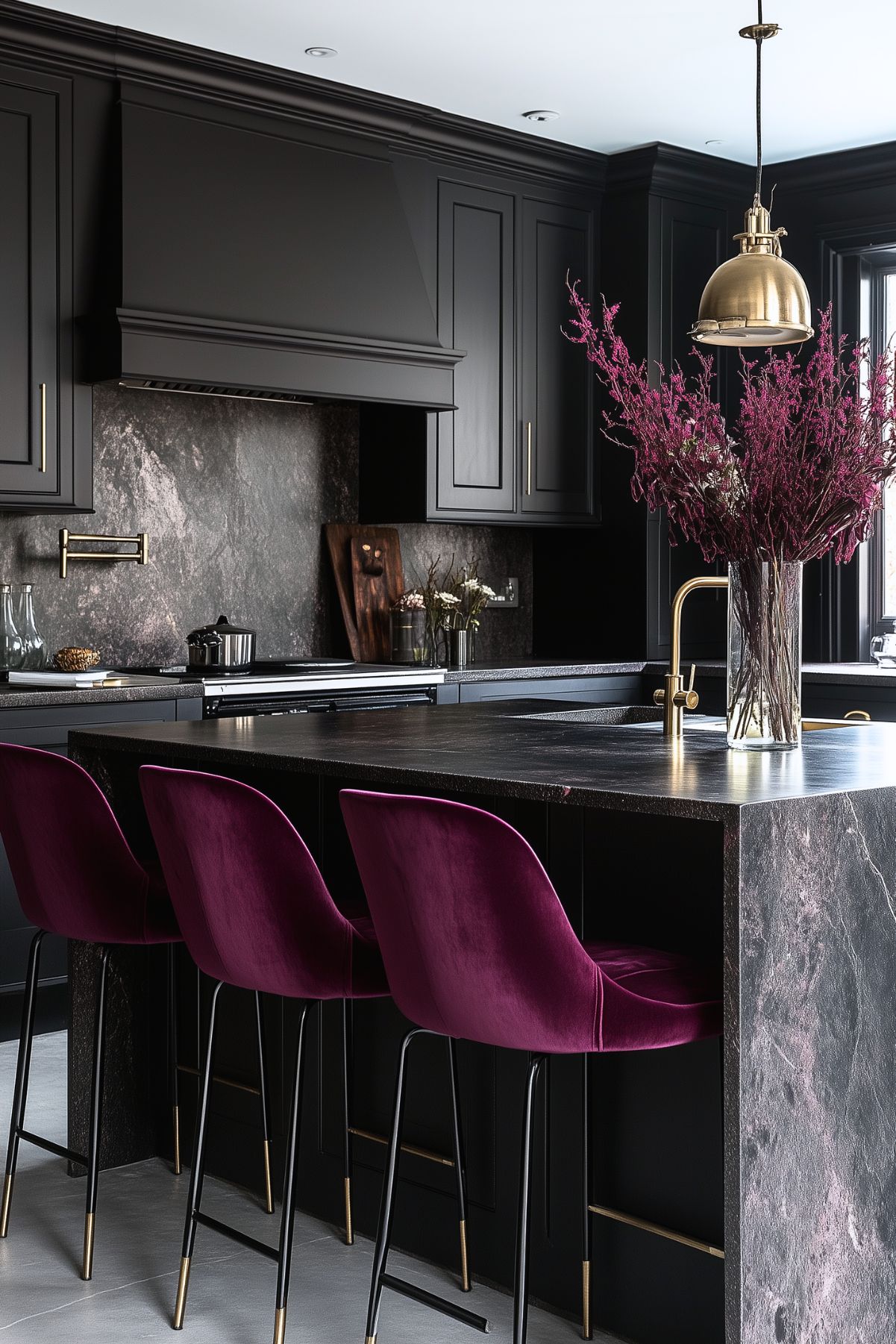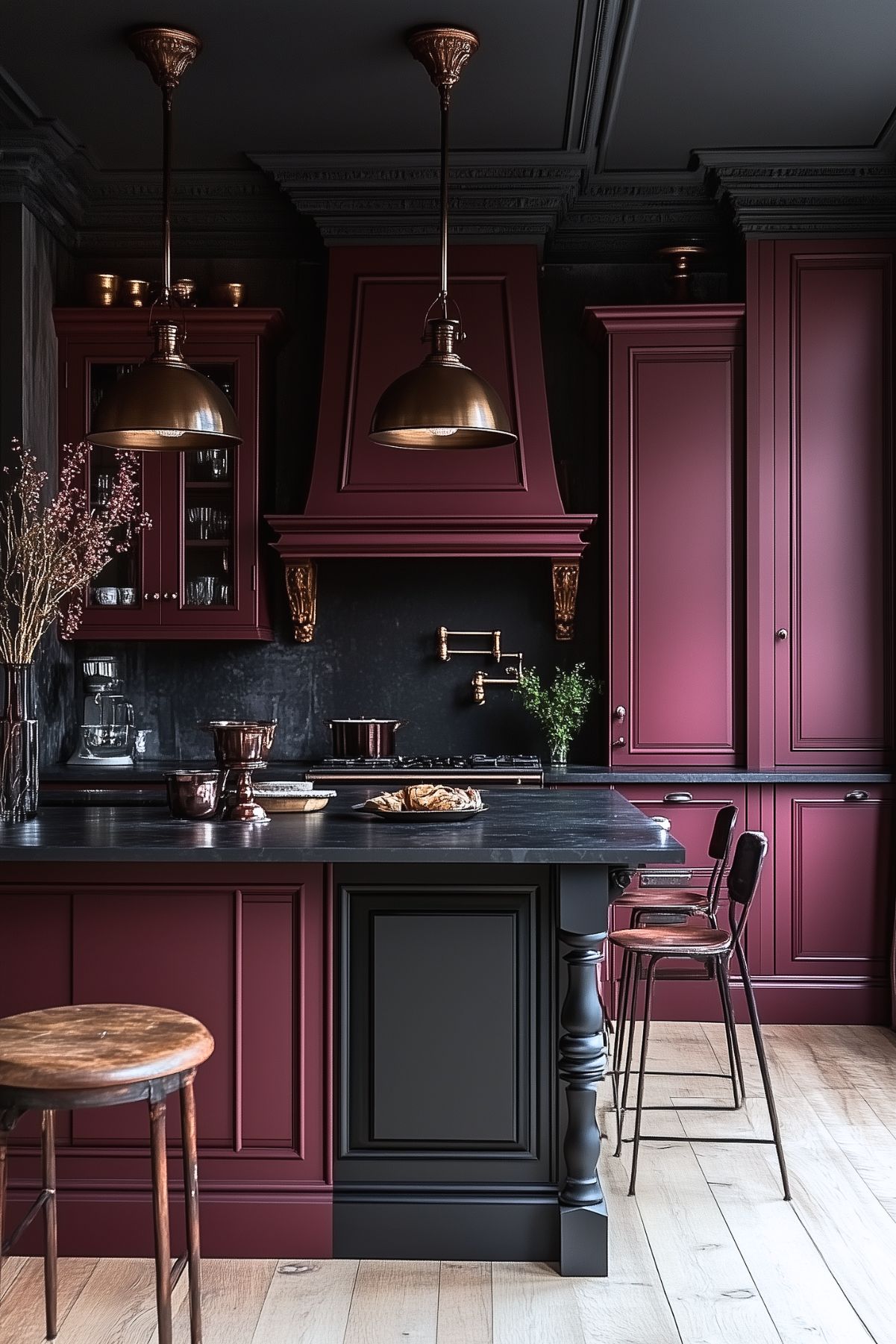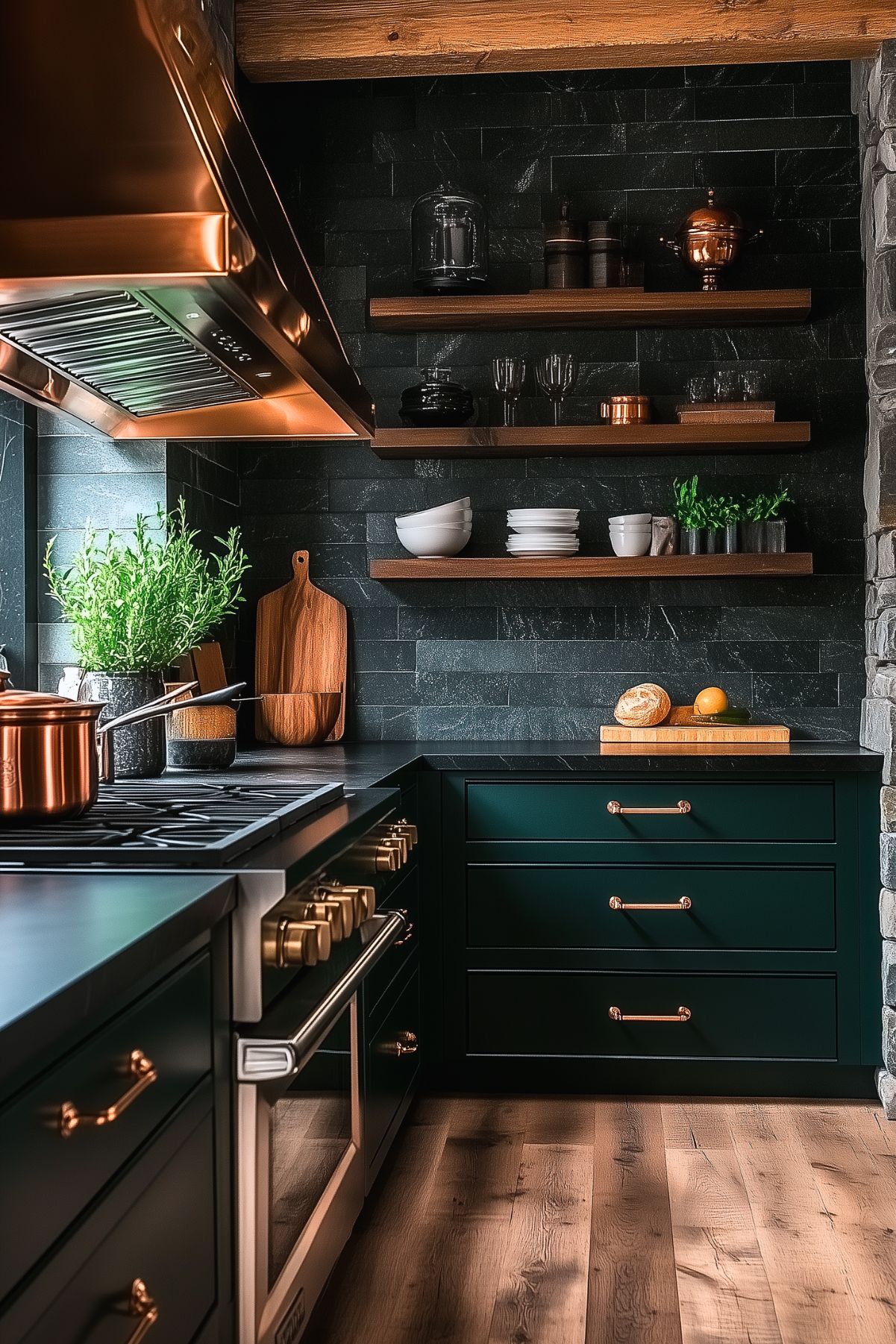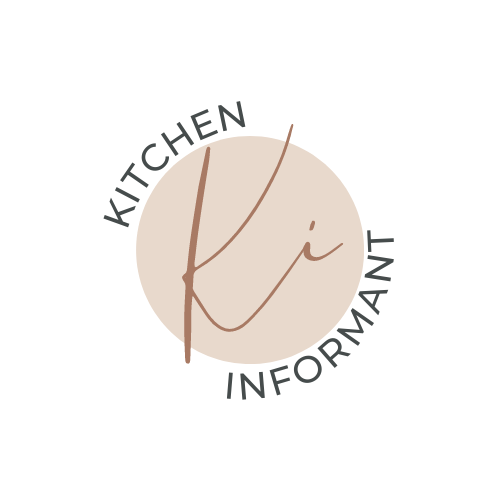The dark kitchen aesthetic is gaining popularity among homeowners and designers alike. This style embraces rich colors, deep materials, and a cozy yet elegant feel that transforms kitchen spaces into inviting culinary hubs.
Creating a dark kitchen can add sophistication and intensity, making it a striking choice for both modern and traditional homes.

Design elements like matte black cabinetry and dark wood accents can enhance warmth while maintaining an edgy look.
Lighting plays a crucial role in this aesthetic. Strategically placed fixtures help balance the darker tones with bright spots, creating a welcoming atmosphere.
For those looking to refresh their kitchen, the dark aesthetic offers many creative possibilities.
Incorporating dark colors does not mean sacrificing light or a feeling of openness. With the right design choices, even smaller kitchens can appear larger and more grand.
This makes the dark kitchen aesthetic not only a trend but an opportunity for homeowners to express their unique style and make their kitchens truly special.
Exploring the Concept of Dark Kitchen Aesthetic

The dark kitchen aesthetic embraces bold design choices that create a unique atmosphere. This style combines color, function, and emotion in a way that resonates with many people today.
Definition and Origin
The dark kitchen aesthetic refers to kitchen designs that use deep, rich colors like black, navy, and dark woods. This trend has its roots in modern minimalism and industrial design.
Material choices play a key role. Matte black cabinets and sleek surfaces create a sophisticated look. Dark wood adds warmth, making spaces feel inviting. This style began gaining popularity in the early 2000s, as homeowners sought to break away from traditional white and bright kitchens.
This aesthetic promotes a cozy yet elegant vibe, appealing to those who enjoy a more dramatic atmosphere in their culinary spaces.
Cultural Significance
Dark kitchens reflect a shift in how people view home spaces. As lifestyles evolve, many seek environments that express personality and creativity. This style encourages a sense of comfort, often blending modern elements with traditional touches.
Culturally, dark kitchens resonate with themes of intimacy and reflection. They provide a backdrop for shared moments among family and friends.
Moreover, this aesthetic resonates with sustainability, often using reclaimed materials and eco-friendly finishes. This combination of style, comfort, and awareness showcases the evolving meaning of home and personal expression in today’s society.
Design Elements of Dark Kitchens

Dark kitchens combine elegance and modernity through thoughtful design choices. Key elements include color palette, lighting, and materials that work harmoniously to create a unique atmosphere.
Color Palette
The color palette in a dark kitchen plays a crucial role in defining its aesthetic. Popular choices include deep blacks, rich grays, and dark blues. These colors provide a sleek and sophisticated backdrop. They can be paired with lighter shades for contrast, making elements like cabinetry and countertops stand out.
Textured finishes, such as matte or satin, can enhance the visual appeal. Adding dark wood tones, like walnut or mahogany, introduces warmth. This blend of dark and rich colors creates a refined atmosphere that feels cozy and inviting.
Lighting and Ambiance
Lighting is essential in a dark kitchen as it sets the mood and highlights design features. Consider using layered lighting for depth. This can involve pendant lights over the island, under-cabinet lighting, and wall sconces to create a warm glow.
Accent lighting adds drama by focusing on artwork or architectural details. Additionally, dimmable fixtures are a great option, allowing users to adjust brightness based on needs or events.
Natural light from windows should be optimized as well. Using light-filtering window treatments can maintain privacy without sacrificing brightness.
Material and Texture Choices
Choosing the right materials and textures enhances the overall design of dark kitchens. Incorporating a mix of materials adds depth and interest. For instance, pairing sleek stone countertops with textured backsplashes creates visual contrast.
Dark wood cabinets bring warmth while metals like brass or matte black fixtures contribute a modern touch.
Incorporating textiles, such as upholstered chairs or rugs, can soften the look and provide comfort. Overall, textures like smooth surfaces, rough stones, and soft fabrics create a balanced and inviting environment.
Dark Kitchen Style Variations

Dark kitchens offer a range of styles that cater to different tastes and preferences. From minimalist designs to luxurious themes, each variation brings its own unique flair.
Minimalist Dark Kitchens
Minimalist dark kitchens focus on clean lines and simplicity. They often use a limited color palette, primarily featuring blacks and grays.
Key elements include smooth cabinetry and unobtrusive hardware. Open shelving can provide functionality while maintaining a streamlined look.
Lighting plays a crucial role in this style. Simple pendant lights or recessed lighting create a warm atmosphere without overwhelming the space.
This style often uses materials like matte finishes and glass to achieve a sleek appearance. The goal is to create an inviting space that’s not cluttered, allowing for easy movement.
Industrial-Inspired Designs
Industrial-inspired dark kitchens blend rustic charm with modern elements. They typically incorporate materials like metal, wood, and concrete.
Exposed pipes and raw wood beams add character and authenticity. Dark cabinets in matte finishes can complement these features beautifully.
The use of vintage lighting fixtures, such as Edison bulbs, adds a nostalgic touch. These lighting choices enhance the kitchen’s industrial vibe.
Open layouts are common in this style, allowing for airflow and a sociable atmosphere. Color accents, such as deep navy or charcoal, can add depth while keeping the overall look cohesive.
Luxurious Themes
Luxurious dark kitchens create a rich and sophisticated environment. They often feature high-end materials like rich woods and marble.
Dark cabinets in high gloss can reflect light beautifully. This topped with gold or brass hardware adds a touch of elegance.
Lighting is key to this style. Crystal chandeliers or designer pendant lights can serve as statement pieces. They draw the eye and elevate the space.
Carefully chosen decor, like elegant bar stools or art pieces, enhances the luxurious feel. This style invites comfort while showcasing stunning design elements that impress.
Adopting Dark Kitchen Aesthetics

Dark kitchen aesthetics can create a cozy and modern space. By using some specific strategies, anyone can successfully adopt this stylish look without feeling overwhelmed.
Focusing on DIY ideas, maintaining color balance, and adding personal touches can make a dark kitchen inviting and unique.
DIY Tips and Ideas
Creating a dark kitchen can start with simple DIY projects. One popular choice is painting cabinets a deep color like matte black or navy blue. These shades add depth and sophistication.
Another idea is to use dark wood for shelving or countertops. Woods like walnut or dark-stained oak provide warmth and richness.
In addition, consider installing a dark backsplash. It can contrast beautifully with lighter fixtures. Small details, such as black hardware or light fixtures, can also enhance the aesthetic. Remember, the key is to coordinate these elements for a cohesive look.
Maintaining Balance with Color
Using dark colors means it’s essential to maintain balance in the kitchen. Pairing dark elements with lighter ones can prevent the space from feeling heavy. For example, white or light-colored walls can brighten up the room.
Another way to balance is by adding colorful accessories. Bright dishware, plants, or artwork can pop against dark surfaces.
To create a harmonious feel, consider the lighting. Natural light can help brighten dark spaces, so keep windows unobstructed. Complementary light sources, such as pendant lights or under-cabinet lighting, can enhance the mood and visibility.
Incorporating Personal Touches
Personal touches can make a dark kitchen feel more inviting. Adding decorative elements like family photos or meaningful art can bring warmth to the design.
They can also choose unique kitchen gadgets or appliances, showcasing their personality. A vintage-style coffee maker or a modern toaster can serve as functional art pieces.
Finally, plants can add life to a dark kitchen. Herbs in small pots or hanging plants can draw the eye. These choices offer a refreshing contrast to the dark aesthetic while enhancing the overall atmosphere.
Impact on Mood and Productivity

The dark kitchen aesthetic can influence mood and productivity in various ways. The choice of colors and design can affect how a person feels while cooking or spending time in the kitchen.
Color Psychology
- Dark Colors: These can create a calm and cozy atmosphere. Colors like deep greens, navy, or charcoal may help reduce stress.
- Bright Accents: Adding bright elements can enhance energy levels. Small pops of color from decor or appliances can bring a lively contrast.
Productivity Boost
A well-designed dark kitchen can support productivity. With a clean, organized space, individuals might find it easier to concentrate.
- Open layouts and logical arrangements encourage movement. This makes cooking and meal prep feel more enjoyable.
Social Engagement
The mood in a dark kitchen can encourage social interaction. The cozy feel invites family members or friends to gather and share meals.
The ambiance can create a warm setting for conversation and connection.
Challenges and Considerations

Creating a dark kitchen can be visually stunning, but there are challenges. It’s essential to think about natural light, maintenance, and how guests might perceive the space.
Natural Light and Visibility
Dark kitchens can feel cozy, but they may also appear smaller and less inviting. A lack of natural light can make the space feel cramped.
To tackle this issue, it’s important to include sufficient lighting options.
Using bright LED lights or pendant fixtures can significantly improve visibility. Large windows or reflective surfaces, like glossy cabinets, can help bounce light around the room.
Another option is to choose lighter colors for countertops or accessories. This contrast can help the dark cabinets stand out while keeping the room from feeling too heavy.
Cleanliness and Maintenance
Dark surfaces highlight dust and stains more easily than lighter ones. This makes cleaning a priority for those who choose dark cabinetry.
Keeping the kitchen looking fresh requires regular upkeep.
Using a soft cloth and non-abrasive cleaners will help maintain a pristine look. Matte finishes can hide fingerprints better than glossy ones, so it is worth considering this when making a choice.
It’s also helpful to have a cleaning routine in place. This could involve daily light cleaning and deeper cleaning once a week.
Centers of activity, like the stove or sink areas, often need more focus.
Perception and Guest Experience
The aesthetic of a dark kitchen can impact how guests feel when they enter. While some may love the stylish look, others might find it unwelcoming.
A dark atmosphere, if not balanced well, may make a space feel too intimate or even oppressive.
Incorporating vibrant accents or light-colored furniture can make the space more inviting. Fresh plants can also add life and contrast to the dark tones.
Consideration of guests’ reactions is important. Creating an inviting atmosphere helps ensure that everyone feels comfortable in the kitchen, regardless of its color scheme.
Future Trends in Kitchen Design

Dark kitchens are becoming increasingly popular. They offer a bold and sophisticated look that many homeowners desire.
Key Trends to Watch:
- Dark Cabinets: Designers are leaning towards deep colors like forest green, dark navy, and charcoal. These shades provide a rich, earthy backdrop for kitchen spaces.
- Glossy Finishes: Glossy surfaces improve visual appeal. They reflect light, making spaces feel larger and more inviting.
- Mixing Materials: Combining dark wood with metals or lighter elements adds depth. This approach creates a balanced and stylish appearance.
- Smart Technology: Kitchens are becoming smarter. Appliances that connect to the internet make cooking and organization easier.
- Sustainable Choices: Eco-friendly materials are in demand. Homeowners want cabinets and countertops made from recycled or sustainable sources.












